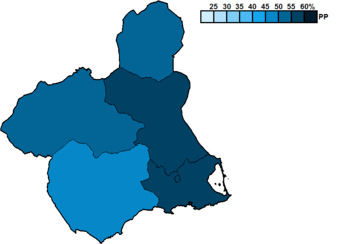Murcian regional election, 2003
|
| |||||||||||||||||||||||||||||||||||||||||
| |||||||||||||||||||||||||||||||||||||||||
All 45 seats in the Regional Assembly of Murcia 23 seats needed for a majority | |||||||||||||||||||||||||||||||||||||||||
|---|---|---|---|---|---|---|---|---|---|---|---|---|---|---|---|---|---|---|---|---|---|---|---|---|---|---|---|---|---|---|---|---|---|---|---|---|---|---|---|---|---|
| Registered |
934,896 | ||||||||||||||||||||||||||||||||||||||||
| Turnout |
654,253 (70.0%) | ||||||||||||||||||||||||||||||||||||||||
| |||||||||||||||||||||||||||||||||||||||||
 Constituency results map for the Regional Assembly of Murcia | |||||||||||||||||||||||||||||||||||||||||
| |||||||||||||||||||||||||||||||||||||||||
The 2003 Murcian regional election was held on Sunday, 25 May 2003, to elect the 6th Regional Assembly of the Autonomous Community of the Region of Murcia. All 45 seats in the Regional Assembly were up for election. The election was held simultaneously with regional elections in twelve other autonomous communities and local elections all throughout Spain.
Overview
Electoral system
The Regional Assembly of Murcia was the devolved, unicameral legislature of the autonomous community of Murcia, having legislative power in regional matters as defined by the Spanish Constitution and the Murcian Statute of Autonomy, as well as the ability to vote confidence in or withdraw it from a President of the Region.[1] Voting for the Regional Assembly was on the basis of universal suffrage, which comprised all nationals over eighteen, registered in the Region of Murcia and in full enjoyment of their political rights.
The 45 members of the Regional Assembly of Murcia were elected using the D'Hondt method and a closed list proportional representation, with a threshold of 5 percent of valid votes—which included blank ballots—being applied regionally. Parties not reaching the threshold were not taken into consideration for seat distribution. Seats were allocated to constituencies, which were established by law as follows:
- I–Lorca (comprising the municipalities of Lorca, Aguilas, Puerto Lumbreras, Totana, Alhama de Murcia, Librilla, Aledo and Mazarrón).
- II–Cartagena (comprising the municipalities of Cartagena, La Unión, Fuente Alamo de Murcia, Torre-Pacheco, San Javier, San Pedro del Pinatar and Los Alcázares).
- III–Murcia (comprising the municipalities of Murcia, Alcantarilla, Beniel, Molina de Segura, Alguazas, Las Torres de Cotillas, Lorquí, Ceutí, Cieza, Abarán, Blanca, Archena, Ricote, Ulea, Villanueva del Río Segura, Ojós, Fortuna, Abanilla and Santomera).
- IV–Northwest (comprising the municipalities of Caravaca, Cehegín, Calasparra, Moratalla, Bullas, Pliego, Mula, Albudeite and Campos del Río).
- V–Plateau (comprising the municipalities of Yecla and Jumilla).
Each constituency was entitled to an initial minimum of one seat, with the remaining 40 allocated among the constituencies in proportion to their populations.[2]
The electoral law provided that parties, federations, coalitions and groupings of electors were allowed to present lists of candidates. However, groupings of electors were required to secure the signature of at least 1 percent of the electors registered in the constituency for which they sought election. Electors were barred from signing for more than one list of candidates. Concurrently, parties and federations intending to enter in coalition to take part jointly at an election were required to inform the relevant Electoral Commission within ten days of the election being called.[2][3][4]
Election date
The term of the Regional Assembly of Murcia expired four years after the date of its previous election. Elections to the Regional Assembly were fixed for the fourth Sunday of May every four years. The previous election was held on 13 June 1999, setting the election date for the Regional Assembly on Sunday, 25 May 2003.[1][2][3][4]
The President of the Region had the prerogative to dissolve the Regional Assembly of Murcia and call a snap election, provided that no motion of no confidence was in process, no nationwide election was due and some time requirements were met: namely, that dissolution did not occur either during the first legislative session or within the legislature's last year ahead of its scheduled expiry, nor before one year had elapsed since a previous dissolution under this procedure. In the event of an investiture process failing to elect a regional President within a two-month period from the first ballot, the Regional Assembly was to be automatically dissolved and a fresh election called. Any snap election held as a result of these circumstances would not alter the period to the next ordinary election, with elected deputies merely serving out what remained of their four-year terms.[1]
Results
Overall
 | |||||||||
| Parties and coalitions | Popular vote | Seats | |||||||
|---|---|---|---|---|---|---|---|---|---|
| Votes | % | ±pp | Total | +/− | |||||
| People's Party (PP) | 367,710 | 56.66 | +3.82 | 28 | +2 | ||||
| Spanish Socialist Workers' Party (PSOE) | 221,392 | 34.11 | –1.80 | 16 | –2 | ||||
| United Left of the Region of Murcia (IURM) | 36,754 | 5.66 | –1.34 | 1 | ±0 | ||||
| The Greens of the Region of Murcia (LVRM) | 10,208 | 1.57 | +0.64 | 0 | ±0 | ||||
| Citizens Convergence of the South-East (CCSE) | 1,194 | 0.18 | +0.04 | 0 | ±0 | ||||
| Humanist Party (PH) | 1,063 | 0.16 | New | 0 | ±0 | ||||
| Family and Life Party (PFyV) | 392 | 0.06 | New | 0 | ±0 | ||||
| National Democracy–Workers' National Party (DN–PNT)1 | 239 | 0.04 | +0.01 | 0 | ±0 | ||||
| Democratic and Social Centre (CDS) | 136 | 0.02 | –0.28 | 0 | ±0 | ||||
| Blank ballots | 9,941 | 1.53 | +0.09 | ||||||
| Total | 649,029 | 45 | ±0 | ||||||
| Valid votes | 649,029 | 99.20 | –0.10 | ||||||
| Invalid votes | 5,224 | 0.80 | +0.10 | ||||||
| Votes cast / turnout | 654,253 | 69.98 | +2.32 | ||||||
| Abstentions | 280,643 | 30.02 | –2.32 | ||||||
| Registered voters | 934,896 | ||||||||
| Sources[5][6][7] | |||||||||
| |||||||||
References
- 1 2 3 "Statute of Autonomy for the Region of Murcia of 1982". Organic Law No. 4 of 9 June 1982. Official State Gazette (in Spanish). Retrieved 22 February 2017.
- 1 2 3 "Region of Murcia Electoral Law of 1987". Law No. 2 of 24 February 1987. Official Gazette of the Region of Murcia (in Spanish). Retrieved 22 February 2017.
- 1 2 "General Electoral System Organic Law of 1985". Organic Law No. 5 of 19 June 1985. Official State Gazette (in Spanish). Retrieved 28 December 2016.
- 1 2 "Representation of the people Institutional Act". juntaelectoralcentral.es. Central Electoral Commission. Retrieved 16 June 2017.
- ↑ "Regional Assembly of Murcia election, 2003". datoselecciones.com (in Spanish). Election Data. Retrieved 30 September 2017.
- ↑ "Regional Elections. Evolution of Turnout and Votes from the Main Political Parties". econet.carm.es (in Spanish). Regional Statistics Center of Murcia. Retrieved 30 September 2017.
- ↑ "Regional Assembly of Murcia elections since 1983". historiaelectoral.com (in Spanish). Electoral History. Retrieved 30 September 2017.
.jpg)
